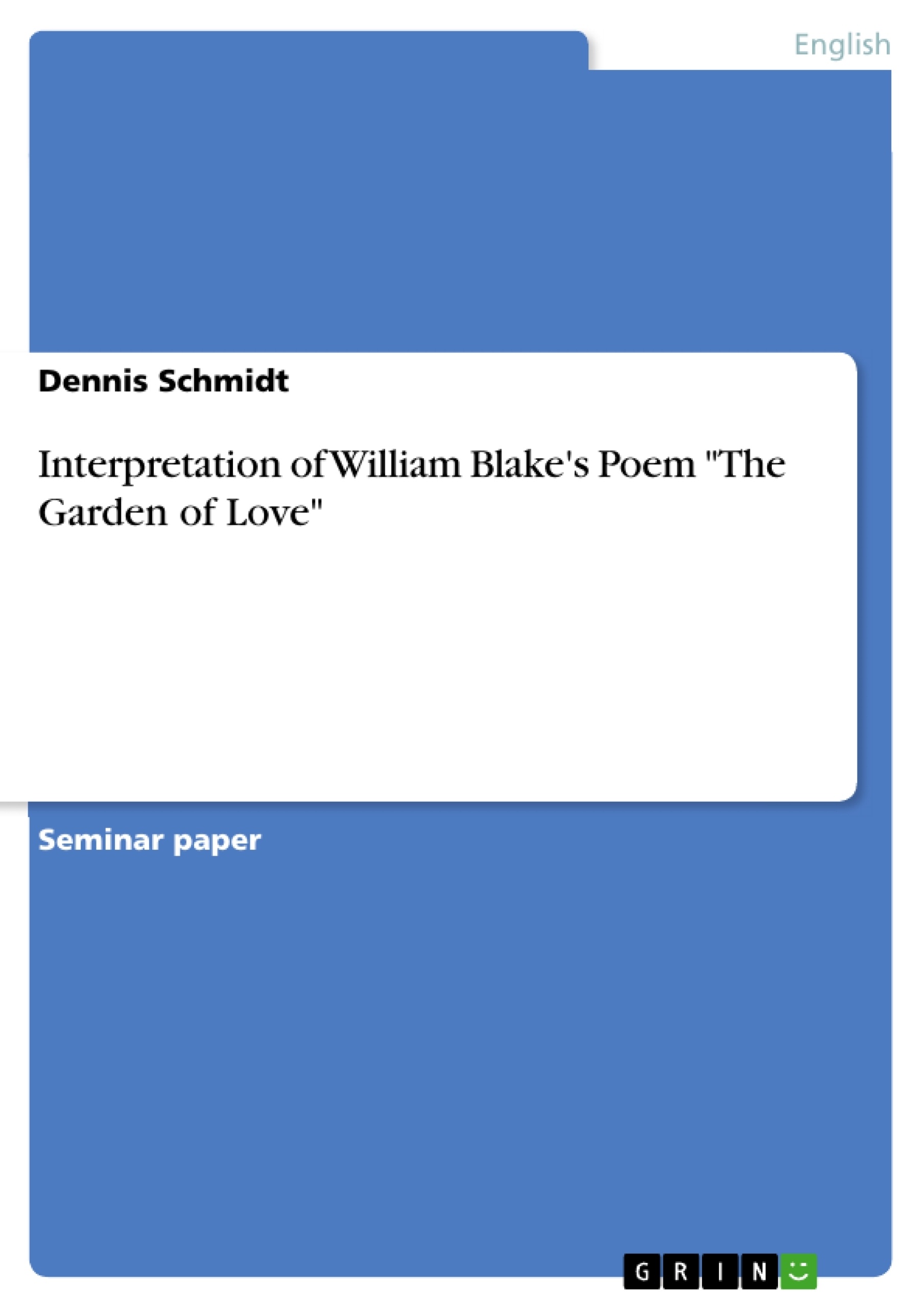Mit seinem Gedicht "The Garden of Love" hat der Romantiker William Blake ein recht kurzes, aber sehr aussagekräftiges Gedicht publiziert: Die zwölf Verse repräsentieren eindrucksvoll seine Haltung zur Church of England sowie typische Merkmale der Epoche der Romantik.
Die vorliegende Interpretation beginnt mit einer formalen Analyse des Gedichts und einer Inhaltsangabe. Es folgt eine detaillierte inhaltliche Analyse und Interpretation der einzelnen Strophen mit Hinblick auf die zuvor aufgestellte Deutungshypothese (Blake's kritische Haltung zur Church of England) sowie der Verknüpfung zwischen Form/Sprache (inkl. Stilmittel) und Inhalt. Schließlich werden die Beobachtungen zusammengefasst.
Table of Contents
- Interpretation of The Garden of Love by William Blake
- Analysis and Interpretation of the Poem
Objectives and Key Themes
The objective of this analysis is to interpret William Blake's poem "The Garden of Love," focusing on his critique of organized religion and the Church of England, and how these sentiments are reflected in the poem's structure, language, and stylistic devices within the context of Romanticism.
- Blake's critique of organized religion and the Church of England
- The use of poetic form and structure to convey meaning
- The symbolic representation of the "Garden of Love"
- The changing mood and tone of the lyrical I throughout the poem
- The impact of stylistic devices on the poem's overall effect
Chapter Summaries
Interpretation of The Garden of Love by William Blake: This section provides a detailed analysis of Blake's poem, examining its formal elements such as rhyme scheme, meter, and stylistic devices like anaphora and alliteration. It discusses the poem's structure, noting the shift in tone and imagery across the three stanzas. The analysis observes an increasing irregularity in rhyme and meter reflecting the lyrical I's growing dismay. The initial idyllic setting transforms into a bleak landscape symbolizing the negative impact of organized religion on personal joy and desire.
Analysis and Interpretation of the Poem: This section delves deeper into the poem's thematic concerns, particularly Blake's criticism of the Church of England. The analysis explores the symbolic significance of the "Garden of Love" and its transformation, linking it to Blake's broader views on faith and societal constraints. The changing emotional state of the lyrical I is meticulously traced, highlighting the poem's shift from initial naivete to bitter disillusionment. The use of stylistic devices like anaphora and alliteration is examined to show how they enhance the poem's emotional impact and reinforce the themes of repression and loss of innocence. A comparison to the suffering of Jesus Christ is drawn, illustrating the lyrical I's feelings of being oppressed and tortured by the church’s strictures.
Keywords
William Blake, The Garden of Love, Romanticism, religious critique, Church of England, poetic form, stylistic devices, anaphora, alliteration, imagery, symbolism, repression, disillusionment, loss of innocence.
Frequently Asked Questions: Interpretation of William Blake's "The Garden of Love"
What is the main objective of this analysis?
The primary goal is to interpret William Blake's poem "The Garden of Love," focusing on his critique of organized religion, specifically the Church of England, and how this critique is expressed through the poem's structure, language, and stylistic devices within the Romantic context.
What are the key themes explored in the analysis?
Key themes include Blake's criticism of the Church of England and organized religion; the poem's use of poetic form and structure to convey meaning; the symbolic representation of the "Garden of Love"; the shifting mood and tone of the lyrical "I"; and the impact of stylistic devices (anaphora, alliteration, etc.) on the poem's overall effect. A comparison to the suffering of Jesus Christ is also drawn.
What aspects of the poem are examined in the "Interpretation of The Garden of Love" section?
This section provides a detailed analysis of the poem's formal elements, including rhyme scheme, meter, and stylistic devices such as anaphora and alliteration. It examines the poem's structure and the shift in tone and imagery across the stanzas, noting the increasing irregularity in rhyme and meter mirroring the lyrical I's growing despair. The transformation of the initial idyllic setting into a bleak landscape, symbolizing the negative impact of organized religion, is also discussed.
What does the "Analysis and Interpretation of the Poem" section cover?
This section delves deeper into the poem's thematic concerns, particularly Blake's criticism of the Church of England. It explores the symbolic significance of the "Garden of Love" and its transformation, connecting it to Blake's broader views on faith and societal constraints. The analysis meticulously traces the changing emotional state of the lyrical "I," highlighting the shift from initial naiveté to bitter disillusionment. The use of stylistic devices to enhance the poem's emotional impact and reinforce themes of repression and loss of innocence is also examined.
What are the keywords associated with this analysis?
Keywords include: William Blake, The Garden of Love, Romanticism, religious critique, Church of England, poetic form, stylistic devices, anaphora, alliteration, imagery, symbolism, repression, disillusionment, and loss of innocence.
What is included in this language preview?
This preview offers a comprehensive overview, encompassing the title, table of contents, objectives and key themes, chapter summaries, and keywords.
- Quote paper
- Dennis Schmidt (Author), 2015, Interpretation of William Blake's Poem "The Garden of Love", Munich, GRIN Verlag, https://www.grin.com/document/308052



